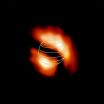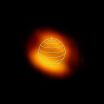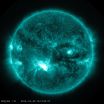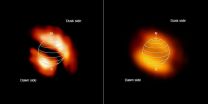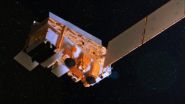(Press-News.org) While studying the atmosphere on Saturn's moon Titan, scientists discovered intriguing zones of organic molecules unexpectedly shifted away from its north and south poles. These misaligned features seem to defy conventional thinking about Titan's windy atmosphere, which should quickly smear out such off-axis concentrations.
"This is an unexpected and potentially groundbreaking discovery," said Martin Cordiner, an astrochemist working at NASA's Goddard Space Flight Center in Greenbelt, Maryland, and the lead author of a study published online today in the Astrophysical Journal Letters. "These kinds of east-to-west variations have never been seen before in Titan's atmospheric gases. Explaining their origin presents us with a fascinating new problem."
This discovery, made during a remarkably brief three-minute "snapshot" observation with the Atacama Large Millimeter/submillimeter Array (ALMA), may help astronomers better understand the processes that shape this world's complex chemistry.
Titan's atmosphere has long been of interest because it acts as a chemical factory, using energy from the Sun and Saturn's magnetic field to produce a wide range of organic molecules. Studying this complex chemistry may provide insights into the properties of Earth's very early atmosphere, which may have shared many chemical characteristics with present-day Titan.
The researchers used ALMA's extreme sensitivity and resolution to track the atmospheric distributions of hydrogen isocyanide (HNC) and cyanoacetylene (HC3N), which initially appeared to be concentrated evenly over Titan's north and south poles. These findings were consistent with observations made by NASA's Cassini spacecraft, which found high concentrations of some gases over whichever pole is experiencing winter on Titan.
The surprise came when the researchers compared the gas concentrations at different levels in the atmosphere. At the highest altitudes, the pockets of organic molecules were shifted away from the poles. These off-pole concentrations are unexpected because the fast-moving, east-west winds in Titan's middle atmosphere should thoroughly mix the molecules formed there.
The researchers do not have an obvious explanation for these findings yet.
"It seems incredible that chemical mechanisms could be operating on rapid enough timescales to cause enhanced 'pockets' in the observed molecules," said Conor Nixon, a planetary scientist at Goddard and a coauthor of the paper. "We would expect the molecules to be quickly mixed around the globe by Titan's winds."
At the moment, the scientists are considering thermal or other effects tied to interaction with Saturn's powerful magnetic field, which extends far enough to engulf Titan, as potential sources of this skewed molecular concentration. "Alternatively, I don't think we could rule out some kind of peculiar atmospheric circulation pattern," speculates Cordiner.
This marks ALMA's first foray into atmospheric studies of a major body in our Solar System. Further observations are expected to improve our understanding of the atmosphere and ongoing processes on Titan and other objects throughout our Solar System.
Titan is in some ways the most Earthlike body in the Solar System, with a thick atmosphere and prominent lakes, rivers, and seas. In place of water, however, Titan's frigid surface flows with liquid organic molecules, including methane (CH4) and ethane (C2H6).
"These ALMA observations give us new insights into how organic molecules, the building blocks of life, form and evolve in a planet-like environment," said Anthony Remijan, an astronomer at the National Radio Astronomy Observatory in Charlottesville, Va., and coauthor on the paper. "It is exciting to imagine the new discoveries ALMA will enable as we look more deeply at other interesting objects in our Solar System."
INFORMATION:
The National Radio Astronomy Observatory is a facility of the National Science Foundation, operated under cooperative agreement by Associated Universities, Inc.
NASA's Astrobiology Program supported this work through a grant to the Goddard Center for Astrobiology, a part of the NASA Astrobiology Institute.
The Atacama Large Millimeter/submillimeter Array (ALMA), an international astronomy facility, is a partnership of Europe, North America and East Asia in cooperation with the Republic of Chile. ALMA is funded in Europe by the European Southern Observatory (ESO), in North America by the U.S. National Science Foundation (NSF) in cooperation with the National Research Council of Canada (NRC) and the National Science Council of Taiwan (NSC) and in East Asia by the National Institutes of Natural Sciences (NINS) of Japan in cooperation with the Academia Sinica (AS) in Taiwan. ALMA construction and operations are led on behalf of Europe by ESO, on behalf of North America by the National Radio Astronomy Observatory (NRAO), which is managed by Associated Universities, Inc. (AUI) and on behalf of East Asia by the National Astronomical Observatory of Japan (NAOJ). The Joint ALMA Observatory (JAO) provides the unified leadership and management of the construction, commissioning and operation of ALMA.
Researchers from the University of Texas Medical Branch at Galveston, University of Kentucky, and University of Maryland found that for people 60 and older who do not have dementia, light alcohol consumption during late life is associated with higher episodic memory — the ability to recall memories of events.
Moderate alcohol consumption was also linked with a larger volume in the hippocampus, a brain region critical for episodic memory. The relationship between light alcohol consumption and episodic memory goes away if hippocampal volume is factored in, providing ...
The sun erupted with another significant flare today, peaking at 10:28 a.m. EDT on Oct. 22, 2014. NASA's Solar Dynamics Observatory captured images of the event, which occurred in the lower half of the sun. This flare is classified as an X1.6 class flare. X-class flares denote the most extreme flares. This is the third substantial flare from the same region of the sun since Oct. 19.
INFORMATION:
To see how this event may affect Earth, please visit NOAA's Space Weather Prediction Center at http://spaceweather.gov, the U.S. government's official source for space weather ...
Invasive seaweed shelters native crustacean
On the tidal mudflats of Georgia and South Carolina, the red Japanese seaweed Gracilaria vermiculophylla is gaining a foothold where no native seaweeds live. Only debris and straggles of dead marsh grass used to break the expanse of mud at low tide. Crabs, shrimp, and small crustaceans mob the seaweed in abundance. What makes it so popular? Not its food value. On mudflats near Savannah, Ga., Wright and colleagues found that the tiny native crustacean Gammarus mucronatus (one of the 9,500 species of amphipod, which includes sand ...
New maps of Saturn's moon Titan reveal large patches of trace gases shining brightly near the north and south poles. These regions are curiously shifted off the poles, to the east or west, so that dawn is breaking over the southern region while dusk is falling over the northern one.
The pair of patches was spotted by a NASA-led international team of researchers investigating the chemical make-up of Titan's atmosphere.
"This is an unexpected and potentially groundbreaking discovery," said Martin Cordiner, an astrochemist working at NASA's Goddard Space Flight Center ...
An interdisciplinary team of researchers from the University of Texas Medical Branch, and Winship Cancer Institute of Emory University have identified small molecules that can represent a new class of anticancer drugs with a novel target for the treatment of lung cancer. These findings are detailed in Nature Communications. A PCT patent (WO 2013028543 A1) was jointly documented by these two Institutes for the invention.
Survival outcomes remain poor for lung cancer patients in large part because of lung cancer's resistance to conventional therapies. Programmed cell death, ...
While space debris was the uncontrolled adversary in the award-winning space thriller film "Gravity," space debris, also known as "space junk," is an ongoing real-life concern for teams managing satellites orbiting Earth, including NOAA-NASA's Suomi National Polar-orbiting Partnership, or Suomi NPP, satellite. It is not unusual for satellites that have the capability of maneuvering to be repositioned to avoid debris or to maintain the proper orbit.
On an otherwise quiet Sunday on September 28, the Suomi NPP mission team was monitoring a possible close approach of a debris ...
Many cancer patients use dietary supplements such as vitamins, minerals and herbs or other botanicals but often don't tell their doctor.
This gap in communication can happen when patients believe that their doctors are indifferent or negative toward their use of these supplements. As a result, patients may find information about dietary supplements from unreliable sources, exposing themselves to unneeded risks. Since information on these dietary supplements is limited, researchers from the University of Texas Medical Branch describe a practical patient-centered approach ...
AMES, Iowa – News of a school shooting or a homicide involving a teenage suspect always leads to the question of why? It is human nature to want an explanation or someone to blame, and policymakers try to pinpoint a cause in an effort to prevent it from happening again. But too often, the speculation or rush to judgment clouds reality, said Matt DeLisi, a professor of sociology and criminal justice at Iowa State University.
"Anytime you have violence, such as a school shooting, people gravitate to single-item explanations that cite mental illness, guns, bullying ...
CHICAGO --- A nano-sized discovery by Northwestern Medicine® scientists helps explain how bipolar disorder affects the brain and could one day lead to new drug therapies to treat the mental illness.
Scientists used a new super-resolution imaging method -- the same method recognized with the 2014 Nobel Prize in chemistry -- to peer deep into brain tissue from mice with bipolar-like behaviors. In the synapses (where communication between brain cells occurs), they discovered tiny "nanodomain" structures with concentrated levels of ANK3 -- the gene most strongly associated ...
VIDEO:
This rainfall analysis showed that Gonzalo generated several areas over the Atlantic Ocean where rainfall totals topped 12 inches (red). Fay's maximum rainfall appeared between 4 and 8 inches (green)....
Click here for more information.
The Tropical Rainfall Measuring Mission or TRMM satellite can estimate rainfall rates from its orbit in space and that data is used to create a rainfall analysis and calculate total rainfall for weather events in the tropics. NASA used ...
